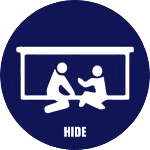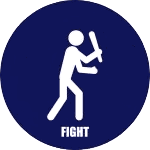An active killer is an individual(s) actively engaged in killing or attempting to kill people in a confined space or another highly-populated area. In most cases, active killers use firearms and display no pattern or method for the selection of their victims. An active killer’s objective is that of mass murder.
Active killer situations are dynamic and evolve rapidly, demanding an immediate response by the community and immediate deployment of law enforcement resources to stop the shooting and prevent further harm to the community.
What you do matters, and we encourage you to remember these three key steps: RUN, HIDE, and FIGHT.
Translations
RUN. HIDE. FIGHT.
Run

If there is an accessible escape path, attempt to immediately evacuate the premises.
- Pay attention to your surroundings.
- Have an exit plan.
- Move away from the threat as quickly as possible.
- The more distance and barriers between you and the threat, the better.
Hide

If evacuation is not possible, find a secure place to hide where the shooter is less likely to find you.
- Keep distance between you and the threat.
- Create barriers to prevent or slow down the threat from getting to you.
- Turn off the lights.
- Remain out of sight and quiet by hiding behind large objects and silencing your phone.
Fight

As a last resort — and only when your life is in imminent danger — attempt to disrupt and/or incapacitate the active shooter.
- Be aggressive, yell, and commit to your actions—your survival depends on it.
- Throw items and use improvised weapons.
- Do not fight fairly — this is about survival.
What to expect from responding police officers
Police officers responding to an active shooter are trained to proceed immediately to the area in which shots were last heard in order to stop the shooting as quickly as possible. The first responding officers may be in teams; they may be dressed in normal patrol uniforms, or they may be wearing external ballistic vests and Kevlar helmets or other tactical gear. The officers may be armed with rifles, shotguns or handguns. Expect to see different uniforms and/or plainclothes officers, as units might be deployed from different departments.
Do exactly as the officers instruct. The first responding officers will be focused on stopping the active shooter and creating a safe environment for medical assistance to be brought in to aid the injured.
The objectives of responding police officers are:
- Immediately engage or contain the active shooter(s) in order to stop the life-threatening behavior.
- First, make sure the environment safe, and then help injured people.
- Identify victims to facilitate medical care, interviews and counseling.
Officers will take command of the situation by shouting orders and/or physically directing individuals to a safe place or the ground.
Additional Training
- Request in-person active shooter training for your UW–Madison campus group/department
- Sign up for campus and community training sessions
- Learn more about our online training option
- Email us if you have questions
